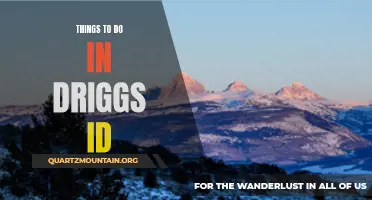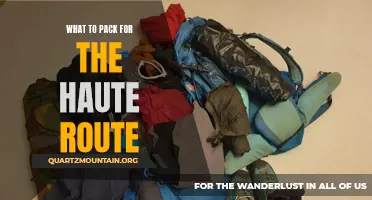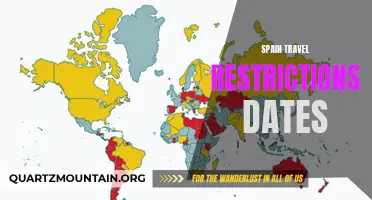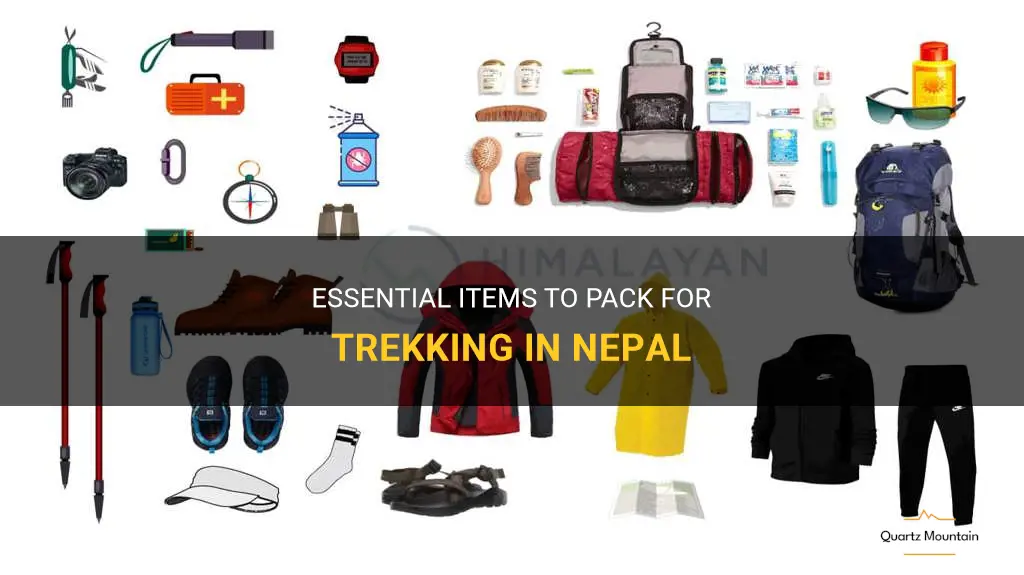
Nepal, a haven for adventure seekers, is famous for its awe-inspiring trekking routes that offer breathtaking views of the Himalayas. From the world-renowned Everest Base Camp trek to the lesser-known Annapurna Circuit, Nepal has something to offer for every trekking enthusiast. However, before embarking on these challenging journeys, it is crucial to pack the right essentials that will help you conquer the rugged terrain and unpredictable weather conditions. In this guide, we will explore the essential items that should be in every trekker's backpack when venturing into the majestic landscapes of Nepal.
| Characteristics | Values |
|---|---|
| Trekking Difficulty | Moderate to Difficult |
| Elevation | Varies from 1,000m to over 5,000m |
| Duration | 7 days to several weeks |
| Weather | Varying temperatures, from hot in lower regions to cold in higher altitudes |
| Accommodation | Tea houses or camping |
| Physical Fitness | Good cardiovascular fitness and stamina |
| Clothing | Layered clothing to adapt to changing weather conditions |
| Footwear | Sturdy and comfortable hiking boots |
| Backpack | Lightweight and durable backpack with good back support |
| Sleeping Bag | Warm and lightweight sleeping bag suitable for the specific season |
| Water Purification | Water purification tablets or filter for safe drinking water |
| First Aid Kit | Essential first aid supplies for emergencies on the trail |
| Trekking Poles | Helps with balance and reduces strain on knees during descents |
| Sun Protection | Sunscreen, sunglasses, and hat to protect from harsh sunlight |
| Headlamp | Essential for early morning or late evening hikes in low light conditions |
| Navigation Tools | Detailed trail map and compass or GPS device |
| Snacks and Energy Bars | Quick and high-energy snacks for sustenance on long treks |
| Cash and Identification | Sufficient cash and identification documents for emergencies |
| Personal Hygiene | Toiletries, wet wipes, and hand sanitizer for maintaining hygiene |
| Camera | Capture the stunning views and memories of the trek |
| Trekking Permits | Obtain necessary permits and licenses for trekking in the region |
| Training | Prepare with regular cardio and strength training exercises |
| Altitude Acclimatization | Slowly ascend and acclimatize to prevent altitude sickness symptoms |
| Local Culture and Etiquette | Respecting local customs and traditions |
| Emergency Contact Information | Keep a list of emergency contacts and important phone numbers |
| Patience and Perseverance | Trekking can be challenging, so maintain a positive mindset and keep going |
What You'll Learn
- What are the essential items one should pack for trekking in Nepal?
- Are there any specific clothing or footwear requirements for trekking in Nepal?
- What kind of backpack is suitable for trekking in Nepal, and what should be included in it?
- Are there any specific medical supplies or medications that should be included in the trekking gear?
- Are there any documents or permits that one should carry while trekking in Nepal, and how can they be obtained?

What are the essential items one should pack for trekking in Nepal?
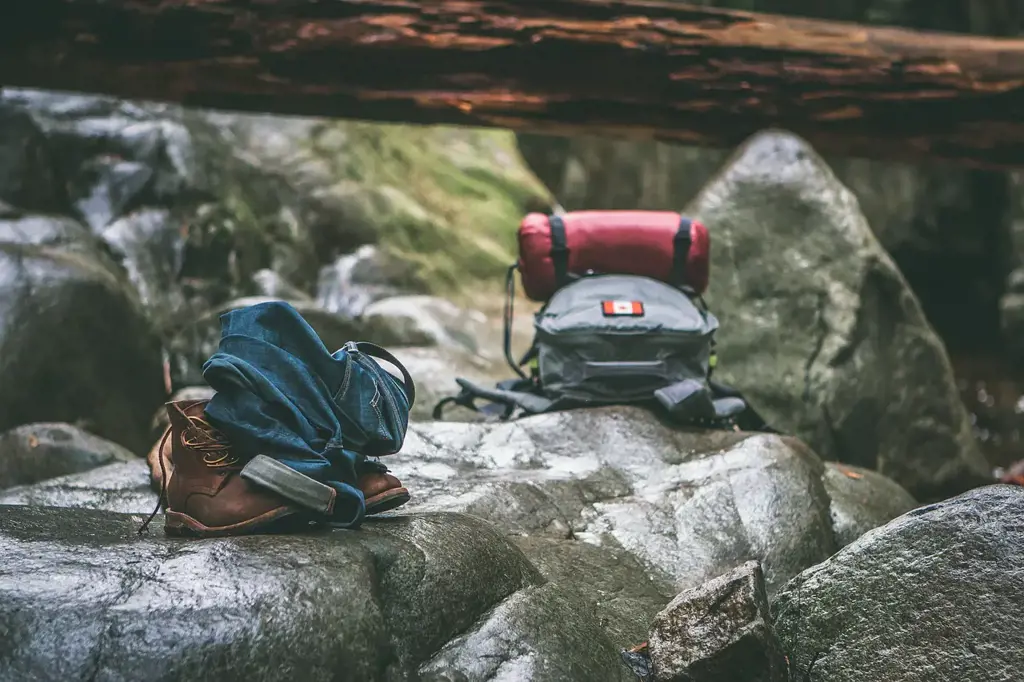
Trekking in Nepal is a magical experience that allows you to explore the breathtaking landscapes of the Himalayas. However, it is crucial to be well-prepared and pack the right equipment to ensure a safe and enjoyable trek. In this article, we will discuss the essential items you should pack when trekking in Nepal.
- Hiking Boots: One of the most important items to pack is a sturdy pair of hiking boots. Trekking in Nepal involves walking long distances over challenging terrains, and good-quality boots will provide the necessary support and protection for your feet.
- Waterproof Jacket: Weather in the Himalayas can be unpredictable, and it is wise to pack a waterproof jacket. This will not only protect you from rain but also serve as a windbreaker. Look for a jacket that is breathable and lightweight to ensure comfort during your trek.
- Warm Clothing: The higher altitudes in Nepal can get extremely cold, especially during the night. Packing warm clothing such as thermal layers, fleece jackets, and down jackets is essential. Be sure to pack enough warm socks and a hat as well.
- Sleeping Bag: Most treks in Nepal involve staying in tea houses or lodges along the way. However, it is still advisable to carry a lightweight sleeping bag. This will ensure you have a clean and comfortable sleeping arrangement, especially in remote areas where tea houses may be limited.
- Backpack: A good-quality backpack is crucial for carrying all your essentials. Look for a backpack with proper shoulder and waist straps for added comfort. Make sure it has enough space to accommodate all your gear and has compartments for easy organization.
- Water Purification Tablets: Drinking water directly from taps or streams in Nepal is not recommended due to the risk of waterborne diseases. Carrying water purification tablets will ensure you have safe drinking water throughout your trek. Alternatively, you can also use a water filter or a portable water purifier.
- First Aid Kit: It is essential to carry a basic first aid kit that includes items like band-aids, antiseptic cream, painkillers, and any personal medications you may need. It is also advisable to familiarize yourself with basic first aid procedures before embarking on the trek.
- Trekking Poles: Trekking poles can be a valuable asset, especially while descending steep slopes or traversing difficult terrains. They help in maintaining balance and reducing the strain on your knees. Adjustable trekking poles are preferred to accommodate different heights and terrains.
- Snacks and Energy Bars: Trekking can be physically demanding, and it is essential to keep your energy levels up. Pack snacks and energy bars that are easy to carry and provide a quick boost of energy when needed. Nuts, dried fruits, and protein bars are good options to consider.
- Sun Protection: The sun can be quite strong at higher altitudes, and it is important to protect yourself from harmful UV rays. Pack a good quality sunscreen with a high SPF, sunglasses, and a hat to shield yourself from the sun.
- Portable Charger: Charging facilities may be limited or unavailable during the trek, so carrying a portable charger for your electronic devices can be helpful. This will ensure you have enough battery power, especially if you need to use your phone for navigation or emergencies.
Remember to pack light and only carry the necessary items to avoid unnecessary strain during your trek. It is also essential to check the weather conditions and specific requirements of the trek you have chosen before packing. Following these guidelines will ensure a safe and enjoyable trekking experience in Nepal.
What to Pack for an Unforgettable Stay at Four Seasons Serengeti
You may want to see also

Are there any specific clothing or footwear requirements for trekking in Nepal?
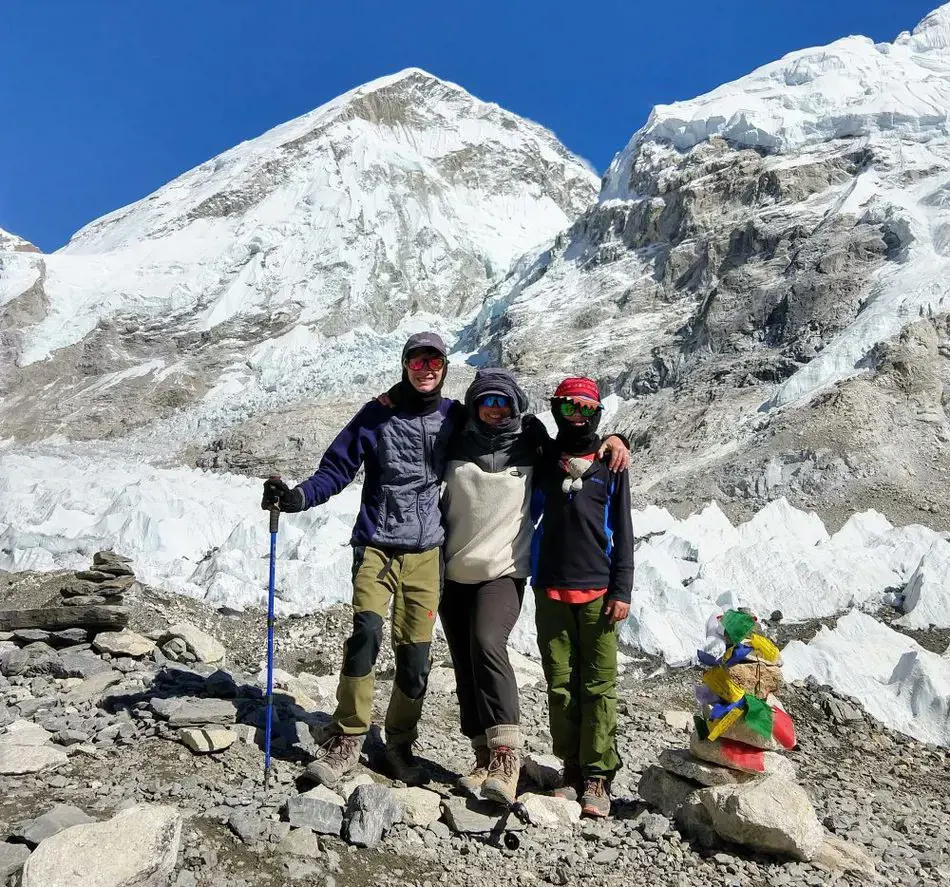
When it comes to trekking in Nepal, proper clothing and footwear are essential for a successful and enjoyable experience. The climate and terrain in the Himalayas can be challenging, and being prepared with the right gear is crucial. In this article, we will discuss the specific clothing and footwear requirements for trekking in Nepal.
Clothing:
Layering is key when it comes to clothing for trekking in Nepal. The weather in the mountains can change rapidly, and having multiple layers allows you to adjust your clothing accordingly. Start with a moisture-wicking base layer that will keep you dry and comfortable. Synthetic or wool materials are best for this purpose.
On top of your base layer, you should have a warm mid-layer, such as a fleece jacket or a down vest. This layer will provide insulation and trap body heat. Make sure it is easy to remove and pack away when you start to warm up during the hike.
For the outer layer, a waterproof and windproof jacket is essential. Look for a jacket that is breathable, so you don't overheat during strenuous climbs. It should also have a hood to protect your head and neck from rain and cold winds.
For your lower body, opt for trekking pants or convertible pants that you can zip off to convert into shorts if necessary. Again, look for quick-drying and lightweight materials. It's also a good idea to bring a pair of thermal leggings or long johns for extra warmth at higher altitudes.
Footwear:
Investing in a good pair of trekking boots is a must for trekking in Nepal. Look for sturdy boots with ankle support and a good tread. They should be waterproof to keep your feet dry in case of rain or snow. Make sure to break in your boots before your trek to avoid blisters and discomfort.
In addition to your trekking boots, it's a good idea to pack a pair of lightweight, breathable shoes for wearing around the campsite. This will give your feet a break from the heavy boots and allow them to breathe.
Other essentials:
In addition to clothing and footwear, there are a few other items that will make your trekking experience in Nepal more comfortable. A hat or cap will protect your head from the sun and also keep it warm in colder temperatures. Sunglasses with UV protection are also important to shield your eyes from the harsh mountain sun.
Gloves are essential for protecting your hands from cold temperatures and wind chill. Look for gloves that are lightweight but insulated to keep your hands warm without hindering your dexterity.
Lastly, don't forget to pack a good quality backpack that is comfortable to wear and has enough space to carry your essentials. Look for a backpack that is lightweight and has adjustable straps for a proper fit.
In conclusion, trekking in Nepal requires specific clothing and footwear to ensure your comfort and safety. Layering is important for adjusting to changing weather conditions, and waterproof and windproof gear is essential. Invest in a good pair of trekking boots and bring lightweight shoes for campsite wear. Don't forget other essentials such as a hat, sunglasses, gloves, and a quality backpack. With the right gear, you'll be well-prepared to tackle the stunning trails of Nepal.
Essential Items to Pack for Your GCU Adventure
You may want to see also

What kind of backpack is suitable for trekking in Nepal, and what should be included in it?
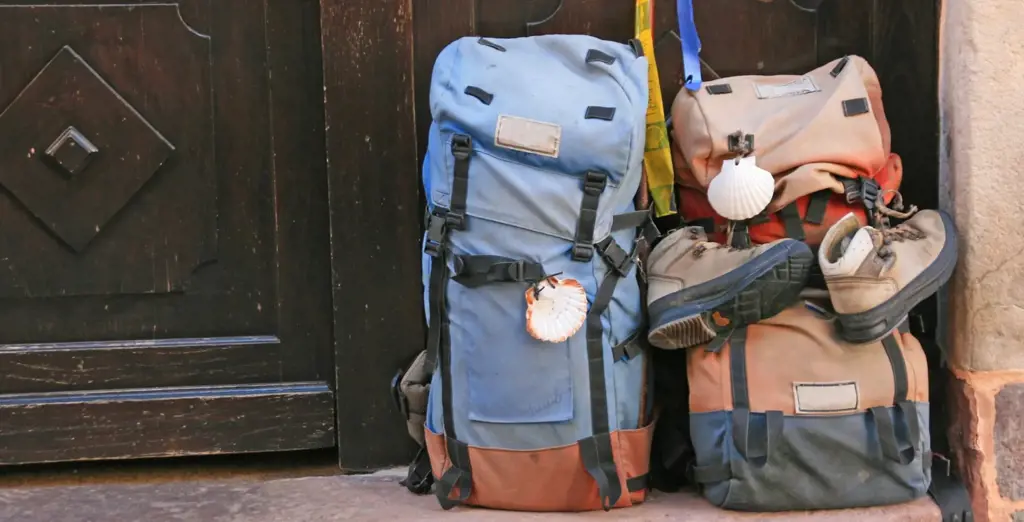
Trekking in Nepal is a popular adventure activity that attracts thousands of tourists every year. The rugged landscapes, breathtaking views, and diverse cultures make it an unforgettable experience. One of the most important things to consider when planning a trek in Nepal is the choice of backpack. A suitable backpack is essential for a comfortable and successful trekking experience. In this article, we will discuss the kind of backpack that is suitable for trekking in Nepal, and what should be included in it.
When choosing a backpack for trekking in Nepal, there are several factors to consider. Firstly, it is important to choose a backpack that is sturdy and durable. The terrain in Nepal can be rough and unpredictable, so it is crucial to have a backpack that can withstand the elements. Look for a backpack made from high-quality materials such as nylon or polyester, with reinforced stitching and strong zippers.
Another important consideration is the size of the backpack. It should be large enough to carry all your essentials, but not so big that it becomes cumbersome to carry. A backpack with a capacity of around 40-50 liters is ideal for trekking in Nepal. This size allows you to carry all your necessary gear, such as clothing, sleeping bag, food, and water, without overloading yourself.
In addition to the size and durability, it is also important to choose a backpack that is comfortable to wear. Look for a backpack that has padded shoulder straps and a hipbelt. These features help distribute the weight evenly and reduce strain on your shoulders and back. Make sure the backpack has adjustable straps so that you can customize the fit to your body.
Now that we know what kind of backpack is suitable, let's discuss what should be included in it. Here is a list of essential items that you should pack for a trekking adventure in Nepal:
- Clothing: Pack enough clothing to last the duration of your trek. Include items such as thermal layers, t-shirts, long-sleeve shirts, fleece jackets, waterproof trousers, and a down jacket for colder temperatures.
- Sleeping bag: A warm sleeping bag is essential for trekking in Nepal. Choose one that is rated for the temperatures you will be encountering during your trek.
- Footwear: Invest in a good pair of trekking boots that provide support and protection. Don't forget to pack a few pairs of warm socks and lightweight sandals for resting at the end of the day.
- Food and water: Carry a sufficient amount of food and water for the duration of your trek. Pack lightweight, high-energy snacks and a water purification system or tablets to treat water from natural sources.
- First aid kit: It is important to have a basic first aid kit that includes items such as bandages, antiseptic ointment, painkillers, and any personal prescription medication.
- Navigation tools: Carry a detailed map of the trekking route, a compass, and a GPS device if possible. These tools will help you stay on track and navigate the often challenging terrain.
- Personal hygiene items: Pack essentials such as toilet paper, wet wipes, hand sanitizer, and a small towel. Remember to follow the principles of Leave No Trace and dispose of waste properly.
- Miscellaneous items: Don't forget to pack a headlamp, extra batteries, a Swiss army knife or multi-tool, a lighter or waterproof matches, a camera, and a power bank for charging electronic devices.
In conclusion, choosing the right backpack is crucial for a successful trekking adventure in Nepal. Look for one that is sturdy, durable, and comfortable to wear. Pack essential items such as clothing, a sleeping bag, footwear, food and water, a first aid kit, navigation tools, personal hygiene items, and miscellaneous items. By being well-prepared and properly equipped, you can make the most of your trekking experience in Nepal.
Essential Items to Pack in an Emergency Bag for Any Situation
You may want to see also

Are there any specific medical supplies or medications that should be included in the trekking gear?
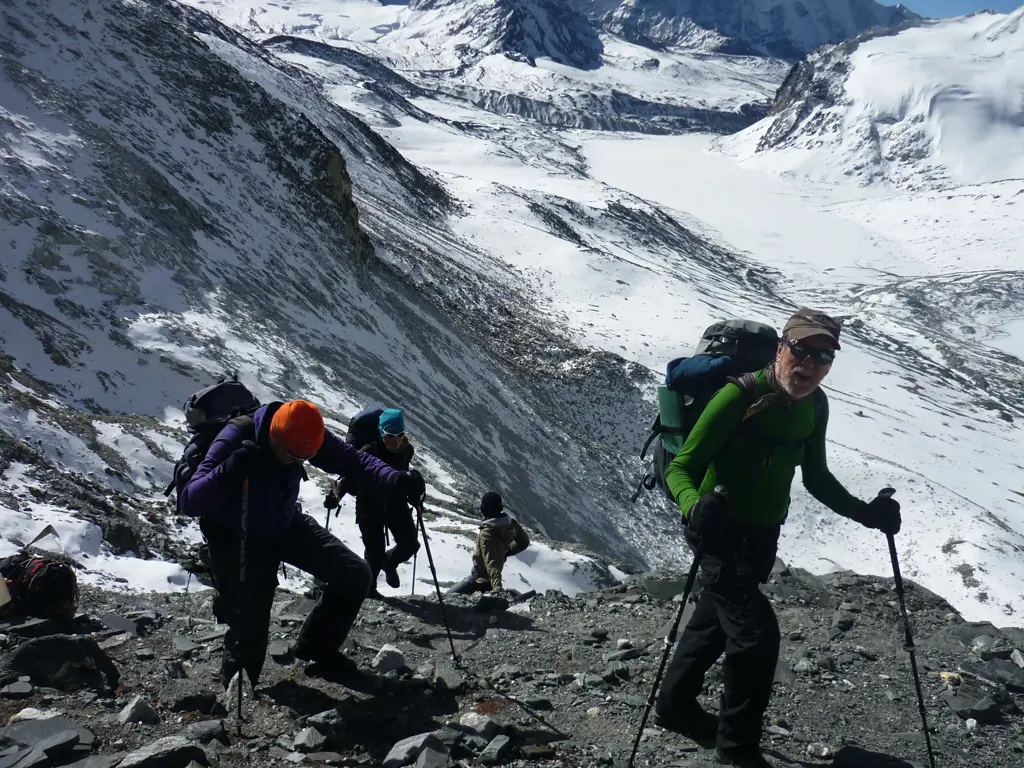
When embarking on a trekking adventure, it is essential to be prepared for any medical situation that may arise. While you may hope for a smooth journey, accidents or illness can happen, so having the necessary medical supplies and medications in your trekking gear can make a significant difference in the outcome of such situations.
Here are some specific medical supplies and medications that should be included in your trekking gear:
First Aid Kit:
A comprehensive first aid kit is a must-have for any trekking expedition. Your first aid kit should include items such as band-aids, gauze pads, adhesive tape, antiseptic wipes, antibiotic ointment, tweezers, scissors, and a thermal blanket. These items can be used to treat minor injuries such as cuts, scrapes, and blisters.
Painkillers:
Painkillers such as ibuprofen or acetaminophen can be helpful in alleviating pain caused by headaches, muscle aches, or minor injuries. These medications can help you continue your trek comfortably if you encounter any discomfort or pain.
Antidiarrheal Medication:
Trekking in unfamiliar environments can sometimes lead to stomach issues, such as diarrhea. Including antidiarrheal medication in your trekking gear can help alleviate these symptoms and allow you to continue your journey without interruption.
Antihistamines:
Insect bites, allergies, or allergic reactions to plants or substances can occur while trekking. Having antihistamines such as Benadryl or cetirizine in your gear can help treat symptoms like itching, swelling, or hives due to allergic reactions.
Prescription Medications:
If you have any pre-existing medical conditions, it is crucial to carry an ample supply of your prescription medications. Make sure you have enough for the duration of your trek, plus a few extra days in case of unexpected delays. Carry your medications in their original packaging with clear labels.
High-Altitude Sickness Medication:
If you are trekking at high altitudes, it is advisable to carry medication for altitude sickness. Acetazolamide, commonly known as Diamox, is a medication that helps prevent and alleviate symptoms of altitude sickness. Consult with a healthcare professional for proper dosing instructions.
Antibiotics:
In case of serious infections or wounds, having a broad-spectrum antibiotic in your trekking gear can be valuable. However, antibiotics should only be used under the guidance of a medical professional, so it is advisable to consult with a healthcare provider before including them in your supply.
Water Purification Tablets:
When trekking in remote areas, access to clean drinking water may be limited. Carrying water purification tablets can help ensure that the water you consume is safe and free from harmful bacteria or parasites.
Remember, it's essential to become familiar with how to use the medical supplies and medications before embarking on your trekking adventure. You should also consult with a healthcare professional for personalized guidance and recommendations based on your health condition and the specific trekking destination.
In conclusion, including a comprehensive first aid kit, painkillers, antidiarrheal medication, antihistamines, prescription medications, high-altitude sickness medication, antibiotics, and water purification tablets in your trekking gear can help you be prepared for any medical situation. By having these supplies on hand, you can ensure your safety and well-being during your trekking adventure.
Essential Items to Pack for Your Costa Rica Trip in February
You may want to see also

Are there any documents or permits that one should carry while trekking in Nepal, and how can they be obtained?
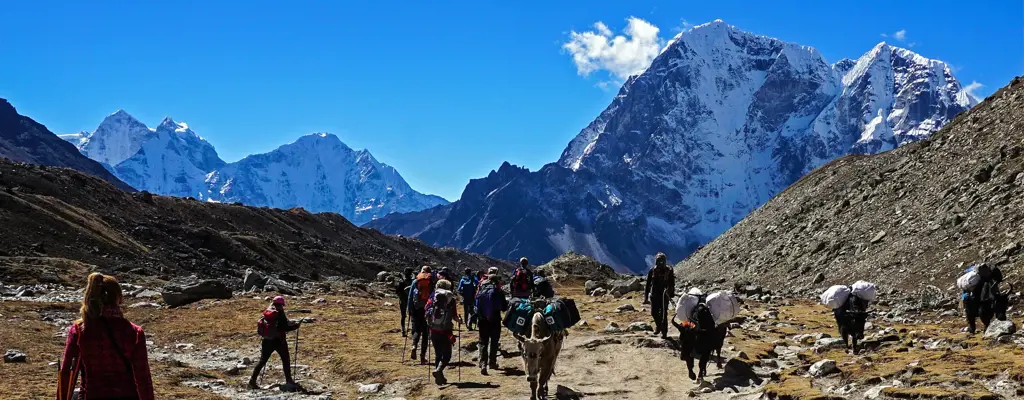
Trekking in Nepal is a popular activity among adventure enthusiasts from around the world. The country is known for its breathtaking landscapes, diverse cultures, and challenging trails. Before embarking on a trekking adventure in Nepal, it is important to be aware of the required documents and permits that you need to carry. This article will guide you through the necessary procedures to obtain these documents and permits.
Trekking Permit:
If you plan to trek in the restricted areas of Nepal, such as Upper Mustang, Manaslu, or Dolpo, you will need a Trekking Permit. This permit is issued by the Department of Immigration in Kathmandu or the Immigration Office in Pokhara. To obtain the permit, you will need to fill the application form, provide a copy of your passport, and pay the required fee. The permit fee varies depending on the region you plan to trek in.
TIMS Card:
The Trekker's Information Management System (TIMS) Card is another important document that you need to carry while trekking in Nepal. This card helps in monitoring the safety and security of trekkers in the various trekking routes. You can obtain the TIMS Card from the Nepal Tourism Board in Kathmandu or the TIMS counter in Pokhara. To apply for the card, you will need to fill in an application form, provide a copy of your passport and visa, and pay the prescribed fee.
Annapurna Conservation Area Permit (ACAP):
If you plan to trek in the Annapurna region, you will need to obtain an Annapurna Conservation Area Permit (ACAP). This permit is required to enter and trek within the Annapurna Conservation Area, which is a protected area. The permit can be obtained from the Nepal Tourism Board in Kathmandu or from the ACAP counter in Pokhara. To apply for the permit, you will need to fill in the application form, provide a copy of your passport and visa, and pay the applicable fee.
Sagarmatha (Everest) National Park Entry Permit:
For trekking in the Everest region, you will need to obtain a Sagarmatha National Park Entry Permit. This permit allows entry into the Sagarmatha National Park, which is home to Mount Everest and several other peaks. The permit can be obtained from the Nepal Tourism Board in Kathmandu or from the Sagarmatha National Park Entry Permit counter in Monjo. Similar to other permits, you will need to fill in an application form, provide a copy of your passport and visa, and pay the necessary fee to obtain this permit.
It is important to note that the procedures and requirements for obtaining these documents and permits may be subject to change. Therefore, it is advisable to check with the relevant authorities or consult a reliable trekking agency in Nepal for the most up-to-date information.
In conclusion, while trekking in Nepal, you need to carry certain documents and permits to comply with the regulations of the country and ensure your safety. These include a Trekking Permit for restricted areas, a TIMS Card for monitoring purposes, an Annapurna Conservation Area Permit for the Annapurna region, and a Sagarmatha National Park Entry Permit for the Everest region. By following the necessary procedures and obtaining these documents and permits in advance, you can have a hassle-free and enjoyable trekking experience in Nepal.
The Essential Guide: Top Items to Avoid Packing When Flying
You may want to see also
Frequently asked questions
When trekking in Nepal, it is important to pack appropriate clothing to protect yourself from the varying weather conditions. You will need to layer your clothing, with a base layer made of moisture-wicking material, such as merino wool or synthetic fabric, to keep you dry. On top of this, wear a warm mid-layer, such as a fleece or down jacket, to provide insulation. Additionally, pack a waterproof and windproof outer layer, such as a breathable Gore-tex jacket, to protect you from rain and snow. Don't forget to bring thermal underwear, hiking pants, moisture-wicking socks, and a sturdy pair of hiking boots.
Proper footwear is essential for trekking in Nepal's rugged terrain. Invest in a good pair of sturdy hiking boots that provide ankle support and have a firm grip on various surfaces. Make sure that your boots are well broken-in before embarking on your trek to prevent blisters and discomfort. It is also a good idea to bring a pair of lightweight sandals or flip-flops for relaxing at the tea houses or wearing in the evenings after a long day of trekking.
Aside from clothing and footwear, there are a few key pieces of equipment you need to pack for trekking in Nepal. Bring a comfortable backpack with a capacity of 30-40 liters to carry your essentials. Also, pack a sleeping bag suitable for the temperature of your trekking route, a trekking pole for added stability, a headlamp with spare batteries, a water bottle or hydration system, and a sturdy and lightweight tent if you plan on camping along the route. It is also a good idea to bring a basic first aid kit and any necessary personal medications.
In addition to clothing, footwear, and equipment, there are a few other essentials you should pack for trekking in Nepal. These include a hat or cap to protect you from the sun, sunglasses with UV protection, sunscreen with a high SPF, a lightweight towel, insect repellent, a power bank or spare batteries for your electronic devices, a portable charger, and a universal travel adapter. It is also wise to pack a few extra plastic bags for waterproofing your belongings and keeping them organized.
Yes, there are some cultural considerations to keep in mind when packing for trekking in Nepal. It is important to dress modestly, especially when visiting monasteries, temples, or rural villages. Avoid clothing that is revealing or offensive to the local culture. Additionally, pack a lightweight scarf or shawl to cover your shoulders or head if needed. It is also respectful to pack toilet paper or tissue paper as it may not be readily available along the trekking routes. Finally, remember to bring a reusable water bottle to minimize plastic waste and respect the environment.


